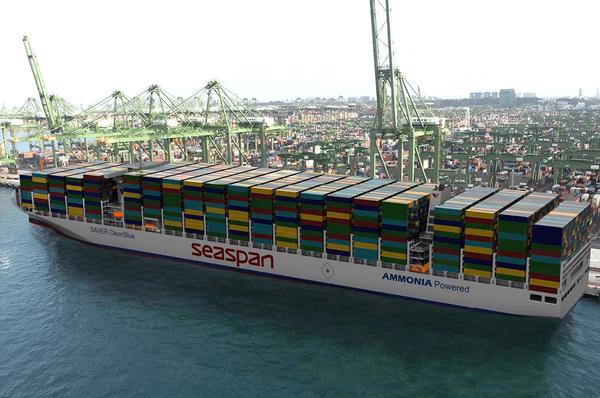FuelEU Maritime will incentivise first movers between 2025-2040 – MMMCZCS
First movers who switch to e-fuels can earn up to $16/GJ by 2040 under FuelEU Maritime's pooling system, finds a Mærsk Mc-Kinney Møller Center for Zero Carbon Shipping (MMMCZCS) report.
 PHOTO: Concept design of a 15,000 TEU ammonia-powered container vessel. LinkedIn of Maersk Mc-Kinney Moller Center for Zero Carbon Shipping
PHOTO: Concept design of a 15,000 TEU ammonia-powered container vessel. LinkedIn of Maersk Mc-Kinney Moller Center for Zero Carbon Shipping
Switching to alternative fuels like green ammonia and e-methanol with zero-emission potential to comply with the upcoming FuelEU Maritime will drastically add to shipowners' costs as they will be required to retrofit vessels to run on these fuels, or order newbuilds compatible with them.
But this cost burden can be mitigated by the pooling mechanism in the upcoming FuelEU Maritime, which is designed to incentivise early movers up until 2040, according to MMMCZCS.
MMMCZCS’ calculations show that each vessel in a pool that is powered by green ammonia or e-methanol can potentially earn overcompliance worth up to $10/gigajoule ($10/GJ) from 2025, and up to $16/GJ from 2040.
FuelEU Maritime will apply an energy multiplier between 2025-2033 to promote use of renewable fuels of non-biological origin (RFNBOs) onboard ships. The multiplier will essentially halve the onboard greenhoues gas (GHG) intensity of the qualifying fuels, and increase the "surplus intensity" of the vessel. To qualify for a RFNBO multiplier, fuel emissions must be lower than 70% of a reference value of 94 gCO2eq/megajoule (MJ) on a well-to-wake basis.
Due to this multiplier, MMMCZCS estimates that a single green ammonia or e-methanol-powered ship can cover emissions of up to 46 VLSFO-powered ships in a pool by 2025. E-methane can cover the emissions of 44 VLSFO vessels, and blue ammonia can cover 26 vessels. In addition, RFNBO-powered vessels are also “eligible to pay zero ETS obligations."
“… the combination of pooling benefits and additional FuelEU and ETS costs on LSFO can close the gap between conventional and alternative fuel costs by 2035. In the case of e-ammonia, the cost is reduced by over 50% from 2035 through 2044,” MMMCZCS explains.
The multiplier advantage will gradually diminish as the GHG intesity targets tighten. By 2030, one green ammonia- or e-methanol vessel will be able to mitigate a smaller 15 VLSFO-powered vessels, and that number will further decline to only two by 2040.
By Konica Bhatt
Please get in touch with comments or additional info to news@engine.online






